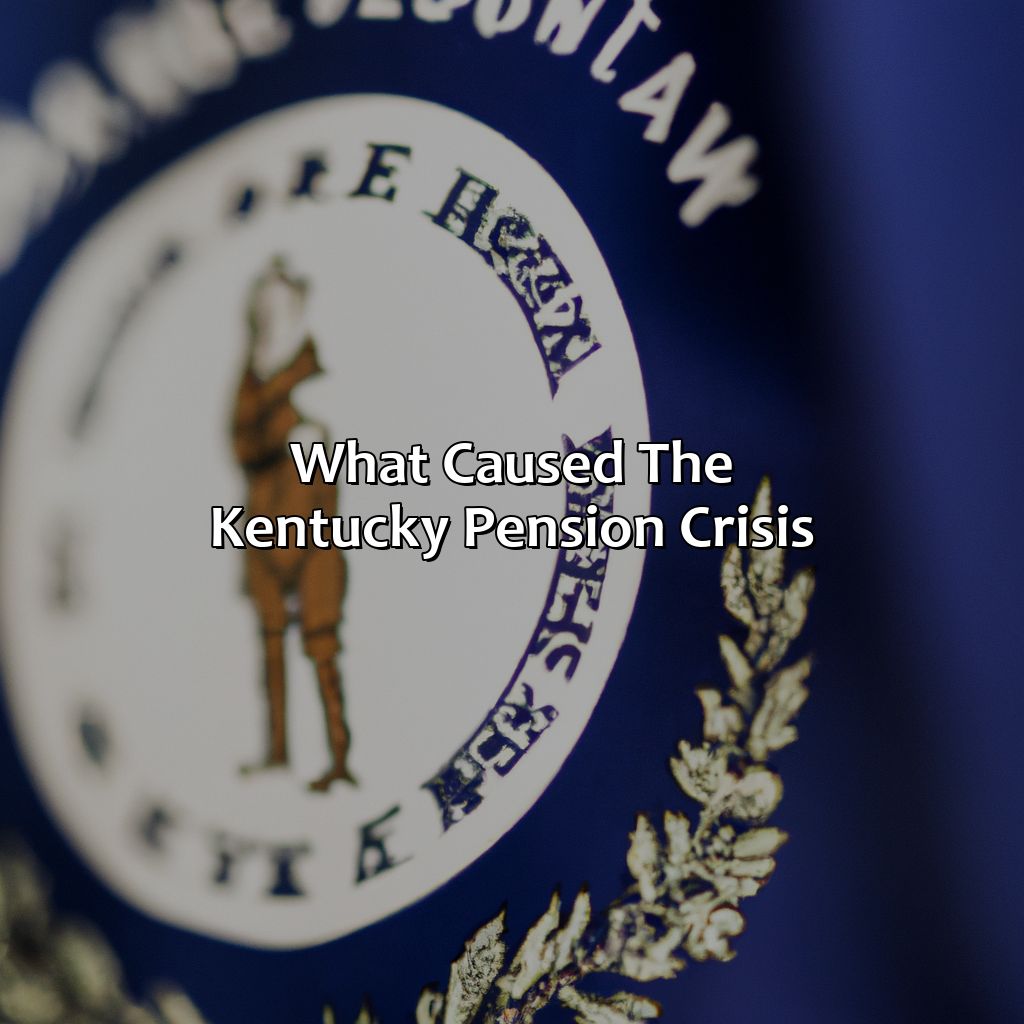What Caused The Kentucky Pension Crisis?
Key Takeaway:
- The Kentucky pension crisis was caused by a combination of underfunding, overly-generous benefits, inefficient investment strategies, failure to increase contributions, and mismanagement of funds.
- The consequences of the crisis include reductions in retirement benefits, budget cuts, and job losses.
- Possible solutions to the crisis include increasing funding levels, lowering benefits, implementing better investment strategies, and raising revenue.
Are you wondering why Kentucky is facing a pension crisis? This article explains the various factors contributing to the state’s precarious financial situation. You’ll gain a deeper understanding of the complexities of the Kentucky pension crisis and uncover the root causes behind it.
Background information on Kentucky pension crisis
The Kentucky pension crisis is a result of poor financial management and stagnant funding. The state’s pension funds have been underfunded for decades, and the government has failed to make adequate contributions to the funds. The state’s pension systems cover over 365,000 workers, and the lack of funding has resulted in a shortfall of over $30 billion. This has led to a decrease in benefits for retired workers and an increase in taxes for current workers. The pension crisis has had a significant impact on the state’s finances, leading to budget cuts in various departments, including education and healthcare.
The Kentucky pension crisis can be traced back to the late 1990s, when the state began to reduce its contributions to the pension funds. This was done to free up funds for other government programs. Additionally, the pension boards were allowed to make unrealistic assumptions about investment returns, which led to overestimation of investment returns. The financial crisis of 2008 worsened the situation, as the funds experienced significant losses. The state has made some efforts to address the crisis, but these measures have been insufficient so far.
The pension crisis in Kentucky has had significant consequences for retired workers and the state’s finances. The government has been forced to cut funding to various departments, leading to reduced services for citizens. Additionally, the crisis has had a negative impact on the state’s credit rating, making it more difficult and expensive for the state to borrow money. The situation highlights the importance of responsible financial management and the need for adequate funding of pension systems.

Image credits: retiregenz.com by David Arnold
Causes of Kentucky pension crisis
To get to the root of the Kentucky pension crisis, we must look at the factors that led to its downfall. Underfunding of pensions, overly-generous benefits and inefficient investment strategies were contributors. Furthermore, not raising contributions and mismanagement of funds only increased the severity. Let’s delve into each of these components to gain a better insight of their influence on the pension crisis in Kentucky.

Image credits: retiregenz.com by David Washington
Underfunding of pensions
The inability of Kentucky to fully fund its pension obligations resulted in the present state of crisis. Despite the fact that these pensions are designed to offer retirement income for public employees, funds have been insufficient. The issue has been prevalent for over a decade, with pensions not receiving adequate funding from state contributions.
This problem was further compounded by the 2008 financial downturn, which impacted pension investments and forced states to take desperate measures in order to sustain their bottom lines. In Kentucky’s instance, benefits such as cost-of-living adjustments were reduced coupled with increasing employees contribution percentages.
It is critical to note that underfunding of pensions in Kentucky is undoubtedly linked to systemic problems plaguing the entirety of America s public pension system. Unforeseen economic changes, particularly those stemming from a global recession led to shortfalls- prompting lawmakers at federal deciders making grand efforts towards avoiding fiscal calamity. Stay up to date on the latest on Kentucky pension changes 2017.
Kentucky’s current challenges have significant consequences for teachers, police officers and other government workers who depend on these resources for sustaining life upon retirement; it is crucial for policymakers to explore all feasible options before these entities fall apart at the seams. To put this matter in context, how would you feel if your retirement savings disappeared? It was not your fault but due to something beyond your control. That is the unfortunate scenario facing many public employees and retirees in Kentucky today.
Kentucky pensions were as overly-generous as a grandma’s hugs, but unfortunately, they weren’t sustainable either.
Overly-generous benefits
The pension crisis in Kentucky has been largely attributed to benefits that were excessively generous. Here are some of the contributing factors that led to this situation:
- High cost-of-living adjustments
- Early retirement options and incentives
- No cap on accrual of vacation days
- Enrollment loopholes for new hires
- Flexible benefit options such as being able to convert sick days into years of service
It is important to note that these overly-generous benefits were not the only factor leading to the pension crisis in Kentucky. Other factors include political mismanagement, poor investment returns, and underfunding. These factors have all contributed to an unsustainable pension system that has caused significant financial strain for retirees and taxpayers alike.
As we consider the causes of the Kentucky pension crisis, it is clear that action needs to be taken to address this issue. This crisis will not solve itself, and if left unchecked could lead to even more significant economic problems in the future. It is crucial that officials take bold steps to address these issues before it’s too late. Let us act soon before we collectively miss out on a peaceful retirement and a comfortable living!
Apparently, investing in Beanie Babies and Pokemon cards wasn’t the best strategy for Kentucky’s pension fund.
Inefficient investment strategies
Improper diversification tactics and flawed decision-making procedures adversely affected the Kentucky pension crisis. The insufficient investment choices made by the state’s officials over time resulted in weak returns and an ongoing pattern of inadequate funding. Failure to understand market dynamics and neglecting alternative options played a significant role in driving down pension fund performance.
Moreover, the funds were invested in expensive and high-risk strategies that some managers lacked expertise or knowledge about. Poor risk management plans, coupled with political interferences, exacerbated matters, leading to underperformance of the investments. These issues indirectly triggered pension cuts and further funding deficiencies.
Pro Tip: Investment decisions require a comprehensive understanding of both current trends and future developments; therefore, it is crucial to get professional counsel before making any decisions that may affect your retirement funds – learn from Kentucky’s example.
Looks like the state of Kentucky skipped math class and failed to see that not increasing contributions would equal a retirement meltdown.
Failure to increase contributions
Contributions not increasing has been a significant cause of the Kentucky pension crisis, leading to substantial holes in state funds. Without sufficient contribution rates, the fund failed to reach anticipated investment targets as it could not accommodate an increasing number of retirees’ demands without running out of money. As a result, the fund has had to borrow to pay pensions, which is essentially a revolving debt that exacerbates the state’s financial obligations.
In reality, the failure to increase contributions occurred over several years, so there was little hope of recouping losses quickly. This led Kentucky to fall behind other states and lose trust among its citizens regarding retirement benefits’ long-term viability with them living longer and requiring more support for retirement income.
Kentucky possessed one of the lowest wage-adjusted employer contributions in America at 8% before cutbacks back in 2013. The amount devoted since then from public employees was 5%. However, both these figures are below actuarially recommended contributions.
According to Business Insider {% cite businessinsiderkentuckypensions %}, 162 out of 216 local pension plans and every plan for large public employee groups still have an underfunding problem out of June 2020.
The only thing worse than mismanaging your funds is mismanaging other people’s funds, which is exactly how Kentucky’s pension crisis came to be.
Mismanagement of funds
The Kentucky pension crisis was caused by the mishandling of funds, leading to a significant shortfall in retirement benefits for state workers. Poor financial management and risky investments contributed to the problem, along with inadequate contributions from employees and the government. The failure to adjust contributions based on changes in demographics also played a role.
Notably, Kentucky’s public pensions were underfunded for decades despite numerous warnings from experts about the sustainability of the system. Various factors also affected the funding, including economic conditions, political decisions, and short-term thinking among stakeholders. This failure to address long-standing issues has resulted in a severe shortage of funds that could have been used to sustain and improve pension benefits.
In recent years, these challenges have led to contentious debates among policymakers and unions about how to address the issue effectively. Some advocate for reducing benefits or increasing employee contributions to shore up funding levels, while others argue for additional government support or restructuring existing pension plans. Despite these challenges, many state workers continue to rely heavily on their pensions as a vital source of retirement income.
One example that highlights the impact of this crisis is former Kentucky school teacher Melissa Brunner’s story. After working for over 27 years as an educator in Kentucky’s public schools, Brunner retired with only $1,300 per month in pension benefits due to funding shortages. She now works part-time at a bookstore to make ends meet and frequently speaks out about the need for better support for retired teachers like herself.
“I hope you like working until you’re 90, because the Kentucky pension crisis is here to stay.”
Consequences of Kentucky pension crisis
Dig deeper into the Kentucky pension crisis and its detrimental effects on its citizens. Reduced retirement benefits, budget cuts, and job losses are some of the main issues people there are experiencing. See how this crisis has impacted individuals and communities in Kentucky.

Image credits: retiregenz.com by Harry Woodhock
Reduction in retirement benefits
The recent fiscal turmoil in Kentucky has resulted in spiraling pension liabilities, forcing authorities to make tough decisions about reducing retirement benefits. The state government attempted to resolve the crisis through a series of reforms, but their efforts fell short of mitigating the issue’s severe consequences.
Reductions in retirement benefits have been devastating for thousands of retired public employees who are struggling to make ends meet while living on limited incomes. Many have had to seek part-time employment or continue working beyond their preferred retirement age, undercutting their quality of life. Combined with an increase in health care expenses, these reductions have produced a dire situation for Kentucky retirees.
To address this catastrophe, Kentucky officials introduced legislation aimed at shoring up the state’s pension system. However, despite making certain adjustments such as reducing healthcare expenses and raising employee contributions, Kentucky’s pension liabilities persist, endangering its pension funds further.
One retiree from Bowling Green was hoping to live his golden years secure and worry-free after serving as an educator for 30 years. He now works part-time at Home Depot to supplement his meager income after having his pensions slashed twice in two years – once due to economic struggles within the district he taught and then due to statewide cuts.
Looks like Kentucky’s budget cuts are leaving teachers with a pension plan that’s as empty as the school’s supply closet.
Budget cuts
The financial crisis in Kentucky brought forth many problems, including monetary challenges and budget cuts. These budget reductions impacted various programs, including state employee benefits and the Kentucky Teachers’ Retirement System. This led to salary freezes and a reduction in workforce personnel, ultimately impacting services provided by the state.
As a result of these budget cuts, pension systems were underfunded, which caused severe deficits in the future. The government’s continuous practice of skipping annual payments intended to finance pensions is one significant cause of this predicament. Budgetary difficulties have also resulted from unsustainably high healthcare expenses for public workers.
However, it is worth noting that not all pensioners shared equal benefits. While some received adequate retirement packages and medical coverage after serving their country for decades, others did not share the same fate due to unbalanced distributions.
Pro Tip: It is necessary for every state to create sustainable fiscal policies that cater to everyone’s needs rather than premium groups only.
Losing your job is never fun, but thanks to the Kentucky pension crisis, it’ll be even less financially rewarding than getting a participation trophy.
Job loss
The Kentucky pension crisis has caused a significant decrease in employment opportunities for Kentuckians. Many companies, both public and private, have had to cut back on their workforce due to budget constraints caused by the state’s underfunded pension system. Some employees have even taken early retirement or left the state altogether in search of more stable job prospects. This loss of jobs has had ripple effects throughout the economy, including decreased consumer spending and tax revenue for local governments.
Furthermore, the job losses resulting from the pension crisis have hit certain industries harder than others. For example, education and healthcare jobs have been particularly affected as these sectors often rely heavily on public funding. The loss of these jobs has also impacted local communities, where businesses may be forced to close due to decreased demand.
It is important to note that the consequences of the Kentucky pension crisis go beyond just job loss. The state’s credit rating has been downgraded multiple times as a result of the unfunded liabilities in its pension system. This makes it more expensive for the state to borrow money, potentially leading to increased taxes or reduced government services in other areas.
In light of these impacts, it is crucial for policymakers to address the underlying issues causing the Kentucky pension crisis before further damage is done. Failure to take action could lead to long-term financial instability and hardship for both current and future generations of Kentuckians.
Time to switch from bourbon to budgeting – Kentucky’s pension crisis needs a solution.
Possible solutions to Kentucky pension crisis
Tackling the Kentucky pension crisis needs solutions. Increasing funds, slashing benefits, optimizing investment strategies and collecting more revenue are some of the options to look into.

Image credits: retiregenz.com by Harry Arnold
Increasing funding levels
The Kentucky pension crisis can be tackled by improving the cash injections. An increase in funding levels can help to resolve the current state of the pension crisis. Elevating the funds that are injected into the pension system will bring a much-needed reform, without forcing beneficiaries to suffer from cuts in their benefits.
A sufficient amount of funding is necessary to ensure retiree benefits remain protected while also stabilizing the pension system. It is crucial to combat potential insolvency risks and protect thousands of retirees’ livelihoods. Therefore, increasing funding levels should be prioritized by government officials and stakeholders.
An alternative solution that complements raising funding levels could be bond issues or levying taxes on investment returns and payments from casino gambling. By finding innovative ways of financing pensions, there will be an increased likelihood of achieving feasible solutions to ensure Kentucky’s long-term financial stability.
According to a recent article by Forbes, “Kentucky’s crisis could have far-reaching implications for investors who rely on state bonds” (Forbes). Therefore, it is vital for those involved in this crisis not only to seek short-term solutions but also implement adequate policies and measures that foster long-term financial growth and security.
Looks like Kentucky pension benefits will be getting a diet – less meat for retirees, more green beans for the state.
Lowering benefits
One potential course of action to address the Kentucky pension crisis is the reduction of retirement benefits. This would entail lowering the amount of money employees receive upon retirement, as well as restructuring pension plans to increase employee contributions. While this solution may be unpopular among workers, it could help alleviate financial strain on the state and ensure future sustainability of pension programs.
Another approach to reducing pension costs could involve implementing a hybrid plan that combines elements of defined benefit and defined contribution plans. This would allow employees to have more control over their retirement savings while still benefiting from a guaranteed level of income in retirement.
Notably, any changes made to pension plans must also consider legal and contractual obligations towards current and retired employees. As such, lowering benefits or other reforms would need to be carefully evaluated in order to balance budgetary concerns with fairness and stability for public workers.
According to a report by NPR, Kentucky’s pension crisis stems from years of underfunding and mismanagement, compounded by factors such as rising healthcare costs and longer lifespans leading to increased payouts.
Let’s hope Kentucky’s new investment strategy involves more than just rubbing a lucky horse shoe for good luck.
Implementing better investment strategies
Enhancing the Investment Approaches for Kentucky Pension Recovery
Efficient investment strategies are vital in the restoration of Kentucky’s pension system. The state needs to implement better investment approaches to tackle the pension crisis efficiently.
The state can consider investing in diverse asset classes such as equities, real estate, and infrastructure assets that possess long-term benefits. Insufficient investment returns have been affecting the state’s economy, which led to lower funding levels.
The implementation of new approaches like reallocation of assets with diversified positions and higher portfolio allocations weighted towards active management could also aid in stabilizing a state’s economy.
Failing pension funds may result in hardships for pensioners. Its impact on firefighters and teachers presents a need for immediate solutions through proactive policies, including stronger investment portfolios calculated over longer time horizons.
Interesting News
A Wall Street-backed start-up acquired KRS. The KY Retirement Systems (KRS) became a part of Clarity AI Solutions’ journey recently. As a result of this deal, Clarity gains more power in influencing crucial decisions regarding KRS finances.”
If Kentucky wants to raise revenue to fix their pension crisis, they should just start charging Mitch McConnell for every time he says ‘no’ to a solution.
Raising revenue
One approach to address the financial distress of Kentucky’s pension system is to explore avenues for increasing revenue streams. This can be achieved through a myriad of ways, including new taxes or fee hikes on selected services, closing tax loopholes or incentives for specific businesses or industries, and instituting online sales taxes. However, it s important to consider that such measures may not yield immediate fiscal relief and must be carefully balanced against potential adverse economic effects.
Moreover, some experts have suggested exploring alternative financing mechanisms like private equity investments, which could potentially provide more significant returns over the long term. However, such an approach carries its own degree of risk and should be evaluated cautiously in terms of industry experiences and impact assessments.
In tandem with revenue-raising efforts, policymakers must also look into other areas that can help address the underlying structural issues within Kentucky’s pension system. For instance, reducing unnecessary administrative expenses like employee perks and benefits might ensure that more resources are devoted towards meeting retirement liabilities effectively.
Pro Tip: Adopting a multifaceted approach in addressing Kentucky’s pension crisis would be indispensable. A combination of innovative strategies tailored to the state’s specific circumstances could prove beneficial in facilitating long-lasting solutions.
Five Facts About What Caused the Kentucky Pension Crisis:
Years of underfunding by the state government contributed to the Kentucky pension crisis. (Source: The New York Times)
The 2008 financial crisis also played a significant role in damaging the Kentucky pension system. (Source: Forbes)
Mismanagement of the pension funds, including risky investments, worsened the crisis. (Source: Courier Journal)
In 2017, Kentucky’s unfunded pension liability reached $33.9 billion, making it one of the worst-funded pension systems in the US. (Source: CNBC)
The Kentucky pension crisis continues to create financial strain on the state budget and has led to cuts in education, healthcare, and other essential services. (Source: Pew Trusts)
FAQs about What Caused The Kentucky Pension Crisis?
What caused the Kentucky pension crisis?
The Kentucky pension crisis stems from years of underfunding of the state’s public pension plans, along with a combination of factors such as the 2008 financial crisis, poor investment returns, inadequate contributions by the state and employees, and generous benefit promises.
How much money is Kentucky’s pension crisis in debt?
Kentucky’s pension system has an unfunded liability of more than $38 billion, making it one of the worst-funded public pension systems in the nation.
What is Kentucky doing to address the pension crisis?
Kentucky has implemented a comprehensive plan to address the pension crisis, including increasing funding levels, reducing benefits for new and some current employees, raising the retirement age, and exploring the possibility of shifting some employees to a defined contribution plan.
Who is affected by the Kentucky pension crisis?
The Kentucky pension crisis affects not only the state employees who rely on these pensions for their retirement, but also taxpayers who will be required to contribute more taxpayer dollars to shore up the system in the next few years.
What are the consequences of not addressing the Kentucky pension crisis?
If the Kentucky pension crisis is not addressed, the state could face a credit downgrade, making it more difficult and expensive to borrow money. In addition, the state could be forced to cut essential services and lay off employees to pay for the increased pension contributions.
Is Kentucky the only state facing a pension crisis?
No. Many states are facing pension crises, including Illinois, New Jersey, and Connecticut. These states, like Kentucky, are struggling with similar issues, such as underfunding, inadequate contributions, and generous benefit promises.
 Checkout this IRS Loophole
Checkout this IRS Loophole 
